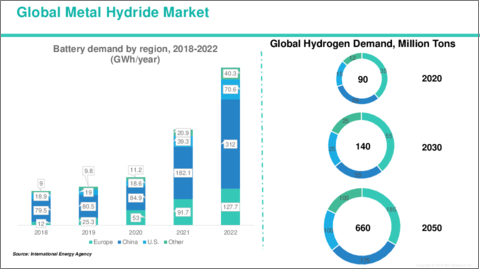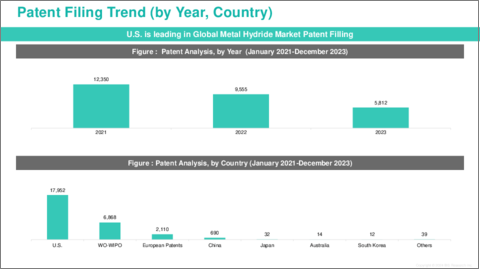|
|
市場調査レポート
商品コード
1500187
メタルハイドライド市場 - 世界および地域の分析:タイプ・用途・地域別の分析・予測 (2024-2034年)Metal Hydride Market - A Global and Regional Analysis: Focus on Type, Application, and Region - Analysis and Forecast, 2024-2034 |
||||||
カスタマイズ可能
|
|||||||
| メタルハイドライド市場 - 世界および地域の分析:タイプ・用途・地域別の分析・予測 (2024-2034年) |
|
出版日: 2024年06月25日
発行: BIS Research
ページ情報: 英文 100 Pages
納期: 1~5営業日
|
- 全表示
- 概要
- 目次
世界のメタルハイドライドの市場規模は、楽観的シナリオで見ると、2024年の42億8,000万米ドルから、CAGR 7.41%で推移し、2034年には87億4,000万米ドルの規模に成長すると予測されています。
メタルハイドライドの市場は、効率的なエネルギー貯蔵ソリューションに対する需要の高まりと水素燃料技術の進歩により、大きな成長を遂げています。水素をコンパクトかつ安全に貯蔵できることで知られるメタルハイドライドは、水素自動車や再生可能エネルギー貯蔵システムの開発において極めて重要です。この市場は、電気自動車 (EV) の普及と持続可能なエネルギーへの世界のシフトによってさらに活性化しています。
| 主要市場統計 | |
|---|---|
| 予測期間 | 2024-2034年 |
| 2024年評価 | 42億8,000万米ドル |
| 2034年予測 | 87億4,000万米ドル |
| CAGR | 7.41% |
ニッケル水素 (NiMH) 電池は、主に環境規制への適合性と再生可能エネルギーへの移行における役割から、メタルハイドライド市場の最前線にあります。カドミウムのような有毒な重金属の使用を避けるこれらの電池は、環境ガイドラインが厳しい市場で特に支持されています。このため、特に国や企業が持続可能性への取り組みを強化するにつれて、さまざまな分野での採用が加速しています。さらに、ニッケル水素技術の成熟は、よりコスト効率の高い生産とバッテリー性能の向上につながり、世界の持続可能性目標によく合致し、環境への影響と効率が優先される分野での適合性を高めています。
地域別では、アジア太平洋がメタルハイドライド市場をリードしています。この主な理由は、堅調な産業成長、再生可能エネルギーへの多額の投資、水素インフラとバッテリー技術に多額の投資を行っている中国、日本、韓国などの主要経済国の存在です。中国と日本は水素燃料電池技術のパイオニアであり、大規模な水素貯蔵や輸送イニシアティブを含む代替エネルギープロジェクトに対して政府から大きなバックアップを受けています。さらに、この地域には世界最大級の電子機器メーカーや自動車メーカーがあり、電池やエネルギー貯蔵ソリューションに金属水素を多用する産業があります。
当レポートでは、世界のメタルハイドライドの市場を調査し、業界の動向、技術・特許の動向、法規制環境、ケーススタディ、市場成長促進要因・抑制要因、市場規模の推移・予測、各種区分・地域/主要国別の詳細分析、競合情勢、主要企業のプロファイルなどをまとめています。
目次
エグゼクティブサマリー
第1章 市場:業界の展望
- 動向:現在および将来の影響評価
- サプライチェーンの概要
- バリューチェーン分析
- 価格予測
- R&Dレビュー
- 特許出願動向:国・年別
- 規制状況
- ステークホルダー分析
- 使用事例
- エンドユーザーと購入基準
- 主要な世界的イベントの影響分析
- 市場力学の概要
- 市場促進要因
- 市場抑制要因
- 市場機会
第2章 メタルハイドライド市場:用途別
- 用途の分類
- 用途の概要
- メタルハイドライド市場:用途別
- 水素貯蔵
- ニッケル水素電池
- 燃料電池
- ヒートポンプ
- 蓄熱
- その他
第3章 メタルハイドライド市場:製品別
- 製品の分類
- 製品の概要
- メタルハイドライド市場:タイプ別
- 合金
- 複合体
- その他
第4章 メタルハイドライド市場:地域別
- メタルハイドライド市場:地域別
- 北米
- 欧州
- アジア太平洋
- その他の地域
第5章 企業プロファイル
- 次なるフロンティア
- 地理的評価
- Merck KGaA
- Albemarle Corporation
- Alkali Metals Ltd
- American Elements
- DalChem
- Ganfeng Lithium Group Co., Ltd
- GfE
- Natrizen Chemicals Pvt. Ltd.
- NIPPON DENKO CO., LTD.
- Thermo Fisher Scientific Inc.
- Triveni Chemicals
- Vizag Chemical International
- Otto Chemie Pvt Ltd
- その他の主要企業
第6章 調査手法
Introduction to Metal Hydride Market
The metal hydride market is experiencing significant growth, driven by the increasing demand for efficient energy storage solutions and advancements in hydrogen fuel technologies. Metal hydrides, known for their ability to store hydrogen in a compact and safe manner, are pivotal in the development of hydrogen-powered vehicles and renewable energy storage systems. The market is further buoyed by the rising adoption of electric vehicles (EVs) and the global shift towards sustainable energy practices. Considering the optimistic scenario the market is valued at $4.28 Billion in 2024 and is expected to grow at a CAGR of 7.41% to reach $8.74 Billion by 2034.
| KEY MARKET STATISTICS | |
|---|---|
| Forecast Period | 2024 - 2034 |
| 2024 Evaluation | $4.28 Billion |
| 2034 Forecast | $8.74 Billion |
| CAGR | 7.41% |
Nickel-Metal Hydride (NiMH) batteries are at the forefront of the metal hydride market, largely due to their compatibility with environmental regulations and their role in the transition to renewable energy. These batteries, which avoid the use of toxic heavy metals such as cadmium, are particularly favored in markets with strict environmental guidelines. This has bolstered their adoption across various sectors, especially as nations and corporations intensify their efforts towards sustainability. Additionally, the maturation of NiMH technology has led to more cost-effective production and improved battery performance, aligning well with global sustainability goals and increasing their desirability in sectors where environmental impact and efficiency are priorities.
Based on Application, the market has been segmented into Hydrogen Storage, NiMH Batteries, Fuel Cells, Heat Pumps, Thermal Storage and Others. Based on Type, the market has been segmented into Alloys, Complexes, and Others.
Asia-Pacific leads the metal hydride market primarily due to its robust industrial growth, significant investments in renewable energy, and the presence of major economies such as China, Japan, and South Korea that are heavily investing in hydrogen infrastructure and battery technology. China and Japan are pioneers in hydrogen fuel cell technology and have substantial government backing for alternative energy projects, which include large-scale hydrogen storage and transportation initiatives. Furthermore, the region is home to some of the world's largest manufacturers of electronics and automobiles, industries that extensively use metal hydrides in batteries and energy storage solutions. For example, Japan's commitment to hybrid vehicles and next-generation batteries has positioned it as a global leader in NiMH battery production and innovation, further driving regional market growth.
The competitive landscape of the metal hydride market is characterized by its dynamic and highly specialized nature, with several key players dominating the scene. These companies are primarily involved in the research and development, production, and application of metal hydrides, particularly for energy storage and battery technologies. Major players such as Thermo Fisher Scientific Inc., Ganfeng Lithium Group Co., Ltd, Albemarle Corporation, and American Elements are at the forefront, leveraging their capabilities in advanced material sciences to improve product efficiency and safety features.
Innovation and strategic partnerships are pivotal strategies within this market. Companies are continuously seeking technological advancements to enhance the storage capacity and release kinetics of metal hydrides. Moreover, collaborations between metal hydride manufacturers and renewable energy companies are becoming more common as both sectors aim to capitalize on the growing demand for sustainable energy solutions. This collaborative approach not only enhances product offerings but also expands market reach and penetration. Additionally, the competitive landscape is influenced by regulatory frameworks promoting low-carbon technologies, which further drive innovation and investment in this sector.
Market Segmentation:
Segmentation 1: by Application
- Hydrogen Storage
- NiMH Batteries
- Fuel Cells
- Heat Pumps
- Thermal Storage
- Others
Segmentation 2: by Type
- Alloys
- Complexes
- Others
Segmentation 3: by Region
- North America
- Europe
- Asia-Pacific
- Rest-of-the-World
How can this Report add value to an Organization?
Product/Innovation Strategy: The global metal hydride market has been extensively segmented based on various categories, such as application, type, and region. This can help readers get a clear overview of which segments account for the largest share and which ones are well-positioned to grow in the coming years.
Competitive Strategy: A detailed competitive benchmarking of the players operating in the global metal hydride market has been done to help the reader understand how players stack against each other, presenting a clear market landscape. Additionally, comprehensive competitive strategies such as partnerships, agreements, and collaborations will aid the reader in understanding the untapped revenue pockets in the market.
Key Market Players and Competition Synopsis
The companies that are profiled have been selected based on thorough secondary research, which includes analyzing company coverage, product portfolio, market penetration, and insights gathered from primary experts.
Some of the prominent companies in this market are:
- Merck KGaA
- Albemarle Corporation
- Ganfeng Lithium Group Co., Ltd
- DalChem
- American Elements
- Triveni Chemicals
Key Questions Answered in this Report:
- What are the main factors driving the demand for global metal hydride market?
- What are the major patents filed by the companies active in the global metal hydride market?
- Who are the key players in the global metal hydride market, and what are their respective market shares?
- What partnerships or collaborations are prominent among stakeholders in the global metal hydride market?
- What are the strategies adopted by the key companies to gain a competitive edge in global metal hydride market?
- What is the futuristic outlook for the global metal hydride market in terms of growth potential?
- What is the current estimation of the global metal hydride market and what growth trajectory is projected from 2024 to 2034?
- Which application, and product segment is expected to lead the market over the forecast period (2024-2034)?
- What could be the impact of growing application in the global metal hydride market?
- Which regions demonstrate the highest adoption rates for global metal hydride market, and what factors contribute to their leadership?
Table of Contents
Executive Summary
Scope and Definition
Market/Product Definition
Key Questions Answered
Analysis and Forecast Note
1. Markets: Industry Outlook
- 1.1 Trends: Current and Future Impact Assessment
- 1.2 Supply Chain Overview
- 1.2.1 Value Chain Analysis
- 1.2.2 Pricing Forecast
- 1.3 R&D Review
- 1.3.1 Patent Filing Trend by Year, by Country
- 1.4 Regulatory Landscape
- 1.5 Stakeholder Analysis
- 1.5.1 Use Case
- 1.5.2 End User and Buying Criteria
- 1.6 Impact Analysis for Key Global Events
- 1.7 Market Dynamics Overview
- 1.7.1 Market Drivers
- 1.7.2 Market Restraints
- 1.7.3 Market Opportunities
2. Metal Hydride Market (by Application)
- 2.1 Application Segmentation
- 2.2 Application Summary
- 2.3 Metal Hydride Market (by Application)
- 2.3.1 Hydrogen Storage
- 2.3.2 NiMH Batteries
- 2.3.3 Fuel Cells
- 2.3.4 Heat Pumps
- 2.3.5 Thermal Storage
- 2.3.6 Others
3. Metal Hydride Market (by Products)
- 3.1 Product Segmentation
- 3.2 Product Summary
- 3.3 Metal Hydride Market (by Type)
- 3.3.1 Alloys
- 3.3.2 Complexes
- 3.3.3 Others
4. Metal Hydride Market (by Region)
- 4.1 Metal Hydride Market (by Region)
- 4.2 North America
- 4.2.1 Regional Overview
- 4.2.2 Driving Factors for Market Growth
- 4.2.3 Factors Challenging the Market
- 4.2.4 Application
- 4.2.5 Product
- 4.2.6 U.S.
- 4.2.6.1 Market by Application
- 4.2.6.2 Market by Product
- 4.2.7 Canada
- 4.2.7.1 Market by Application
- 4.2.7.2 Market by Product
- 4.2.8 Mexico
- 4.2.8.1 Market by Application
- 4.2.8.2 Market by Product
- 4.3 Europe
- 4.3.1 Regional Overview
- 4.3.2 Driving Factors for Market Growth
- 4.3.3 Factors Challenging the Market
- 4.3.4 Application
- 4.3.5 Product
- 4.3.6 Germany
- 4.3.6.1 Market by Application
- 4.3.6.2 Market by Product
- 4.3.7 France
- 4.3.7.1 Market by Application
- 4.3.7.2 Market by Product
- 4.3.8 U.K.
- 4.3.8.1 Market by Application
- 4.3.8.2 Market by Product
- 4.3.9 Italy
- 4.3.9.1 Market by Application
- 4.3.9.2 Market by Product
- 4.3.10 Rest-of-Europe
- 4.3.10.1 Market by Application
- 4.3.10.2 Market by Product
- 4.4 Asia-Pacific
- 4.4.1 Regional Overview
- 4.4.2 Driving Factors for Market Growth
- 4.4.3 Factors Challenging the Market
- 4.4.4 Application
- 4.4.5 Product
- 4.4.6 China
- 4.4.6.1 Market by Application
- 4.4.6.2 Market by Product
- 4.4.7 Japan
- 4.4.7.1 Market by Application
- 4.4.7.2 Market by Product
- 4.4.8 India
- 4.4.8.1 Market by Application
- 4.4.8.2 Market by Product
- 4.4.9 South Korea
- 4.4.9.1 Market by Application
- 4.4.9.2 Market by Product
- 4.4.10 Rest-of-Asia-Pacific
- 4.4.10.1 Market by Application
- 4.4.10.2 Market by Product
- 4.5 Rest-of-the-World
- 4.5.1 Regional Overview
- 4.5.2 Driving Factors for Market Growth
- 4.5.3 Factors Challenging the Market
- 4.5.4 Application
- 4.5.5 Product
- 4.5.6 South America
- 4.5.6.1 Market by Application
- 4.5.6.2 Market by Product
- 4.5.7 Middle East and Africa
- 4.5.7.1 Market by Application
- 4.5.7.2 Market by Product
5. Companies Profiled
- 5.1 Next Frontiers
- 5.2 Geographic Assessment
- 5.2.1 Merck KGaA
- 5.2.1.1 Overview
- 5.2.1.2 Top Products/Product Portfolio
- 5.2.1.3 Top Competitors
- 5.2.1.4 Target Customers
- 5.2.1.5 Key Personnel
- 5.2.1.6 Analyst View
- 5.2.1.7 Market Share
- 5.2.2 Albemarle Corporation
- 5.2.2.1 Overview
- 5.2.2.2 Top Products/Product Portfolio
- 5.2.2.3 Top Competitors
- 5.2.2.4 Target Customers
- 5.2.2.5 Key Personnel
- 5.2.2.6 Analyst View
- 5.2.2.7 Market Share
- 5.2.3 Alkali Metals Ltd
- 5.2.3.1 Overview
- 5.2.3.2 Top Products/Product Portfolio
- 5.2.3.3 Top Competitors
- 5.2.3.4 Target Customers
- 5.2.3.5 Key Personnel
- 5.2.3.6 Analyst View
- 5.2.3.7 Market Share
- 5.2.4 American Elements
- 5.2.4.1 Overview
- 5.2.4.2 Top Products/Product Portfolio
- 5.2.4.3 Top Competitors
- 5.2.4.4 Target Customers
- 5.2.4.5 Key Personnel
- 5.2.4.6 Analyst View
- 5.2.4.7 Market Share
- 5.2.5 DalChem
- 5.2.5.1 Overview
- 5.2.5.2 Top Products/Product Portfolio
- 5.2.5.3 Top Competitors
- 5.2.5.4 Target Customers
- 5.2.5.5 Key Personnel
- 5.2.5.6 Analyst View
- 5.2.5.7 Market Share
- 5.2.6 Ganfeng Lithium Group Co., Ltd
- 5.2.6.1 Overview
- 5.2.6.2 Top Products/Product Portfolio
- 5.2.6.3 Top Competitors
- 5.2.6.4 Target Customers
- 5.2.6.5 Key Personnel
- 5.2.6.6 Analyst View
- 5.2.6.7 Market Share
- 5.2.7 GfE
- 5.2.7.1 Overview
- 5.2.7.2 Top Products/Product Portfolio
- 5.2.7.3 Top Competitors
- 5.2.7.4 Target Customers
- 5.2.7.5 Key Personnel
- 5.2.7.6 Analyst View
- 5.2.7.7 Market Share
- 5.2.8 Natrizen Chemicals Pvt. Ltd.
- 5.2.8.1 Overview
- 5.2.8.2 Top Products/Product Portfolio
- 5.2.8.3 Top Competitors
- 5.2.8.4 Target Customers
- 5.2.8.5 Key Personnel
- 5.2.8.6 Analyst View
- 5.2.8.7 Market Share
- 5.2.9 NIPPON DENKO CO., LTD.
- 5.2.9.1 Overview
- 5.2.9.2 Top Products/Product Portfolio
- 5.2.9.3 Top Competitors
- 5.2.9.4 Target Customers
- 5.2.9.5 Key Personnel
- 5.2.9.6 Analyst View
- 5.2.9.7 Market Share
- 5.2.10 Thermo Fisher Scientific Inc.
- 5.2.10.1 Overview
- 5.2.10.2 Top Products/Product Portfolio
- 5.2.10.3 Top Competitors
- 5.2.10.4 Target Customers
- 5.2.10.5 Key Personnel
- 5.2.10.6 Analyst View
- 5.2.10.7 Market Share
- 5.2.11 Triveni Chemicals
- 5.2.11.1 Overview
- 5.2.11.2 Top Products/Product Portfolio
- 5.2.11.3 Top Competitors
- 5.2.11.4 Target Customers
- 5.2.11.5 Key Personnel
- 5.2.11.6 Analyst View
- 5.2.11.7 Market Share
- 5.2.12 Vizag Chemical International
- 5.2.12.1 Overview
- 5.2.12.2 Top Products/Product Portfolio
- 5.2.12.3 Top Competitors
- 5.2.12.4 Target Customers
- 5.2.12.5 Key Personnel
- 5.2.12.6 Analyst View
- 5.2.12.7 Market Share
- 5.2.13 Otto Chemie Pvt Ltd
- 5.2.13.1 Overview
- 5.2.13.2 Top Products/Product Portfolio
- 5.2.13.3 Top Competitors
- 5.2.13.4 Target Customers
- 5.2.13.5 Key Personnel
- 5.2.13.6 Analyst View
- 5.2.13.7 Market Share
- 5.2.14 Other Key Players
- 5.2.1 Merck KGaA






